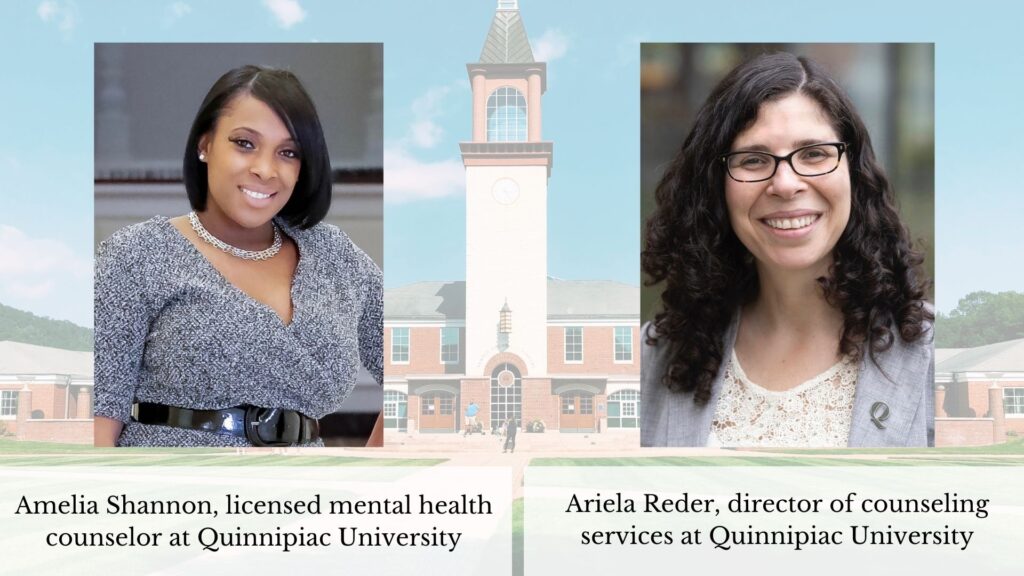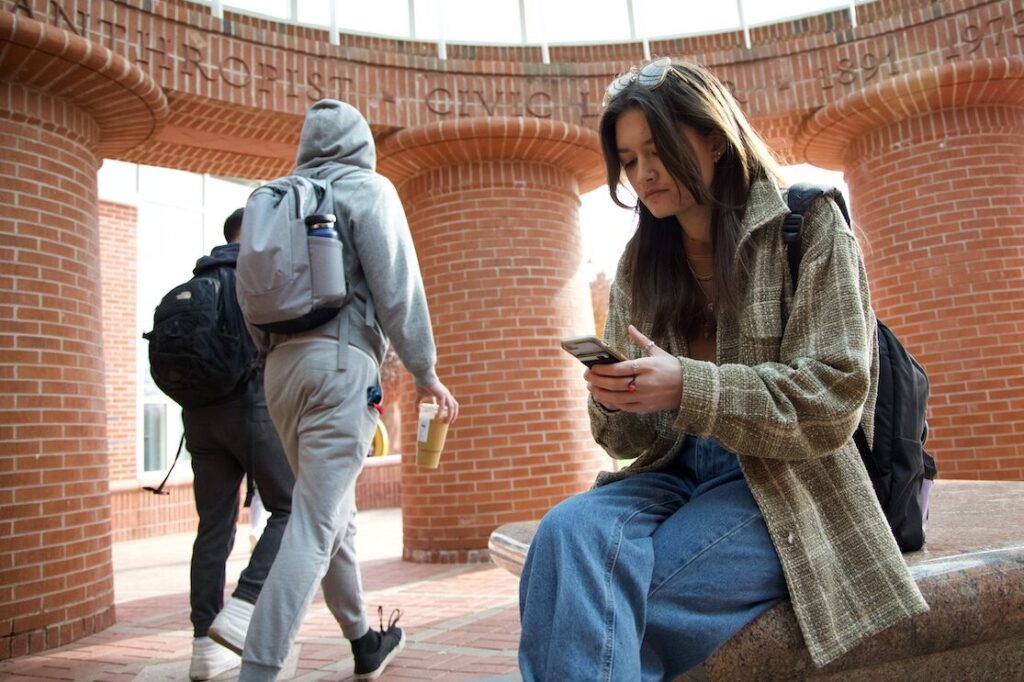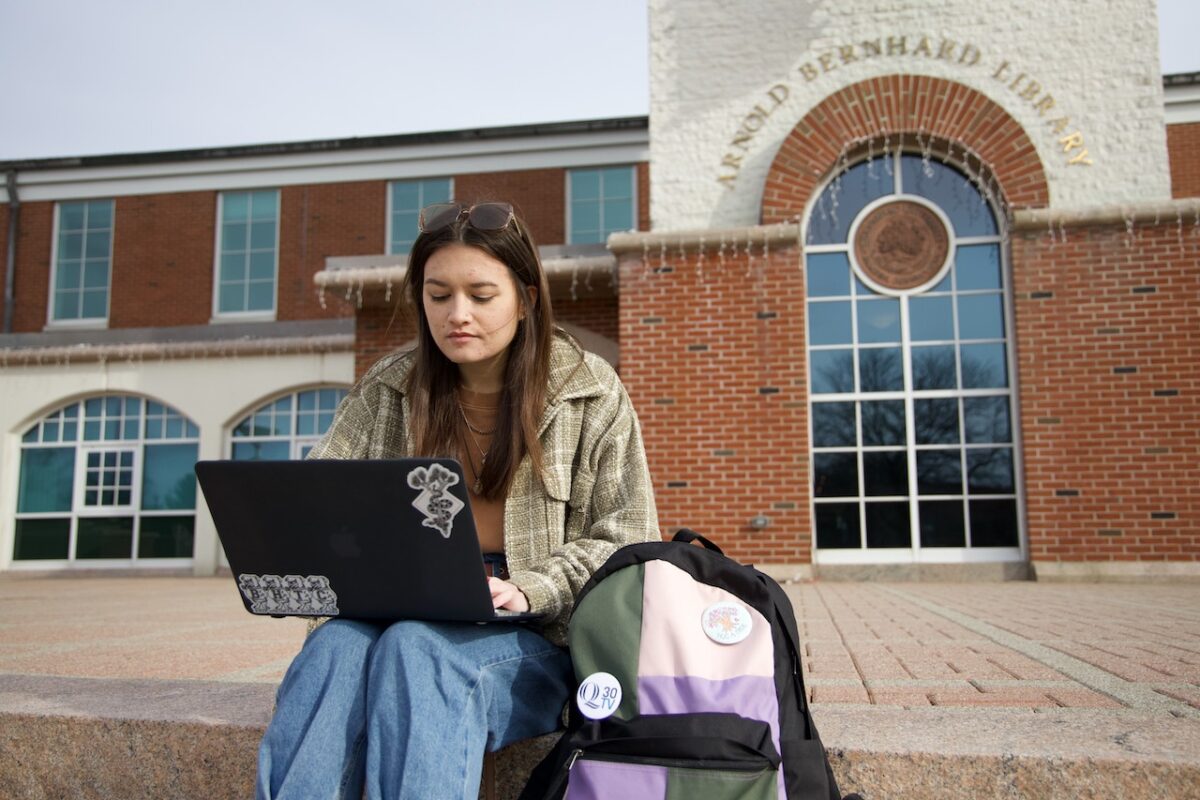It’s every college student’s daily routine: put on a mask, walk to class and hope to get an education without contracting COVID-19.
For Alyssa Murphy, a student pursuing her MBA at Quinnipiac University, this everyday pattern hasn’t been so simple.
“I’m just so overwhelmed,” she said.
After a year and six months full of fear, isolation and widespread illness due to the COVID-19 pandemic, New Haven County college students made their return back to on-campus life this semester.
In March 2020, the COVID-19 pandemic forced college students to replace their classrooms and on-campus activities with laptops and childhood bedrooms in what became a crisis-provoked style of learning. Eighteen months later, as vaccines, masks and science have provided folks with a better grip on the pandemic, many college students were able to reverse that rapid adjustment, but it hasn’t been easy.
Rabbi Reena Judd, who has worked at Quinnipiac University for 17 years, is worried for students like she never has been before.
“It’s painful to see so many hurt young people and know the only way out is through,”
Rabbi Reena Judd, Quinnipiac University
Judd mentioned that she values her privilege to see students through a unique perspective as someone who is not solely an authority figure on campus. She also acknowledged that mental health professionals on campus see students in a rare light as well.
Amelia Shannon, a licensed counselor at Quinnipiac University, said she feels the major shifts society has had to take have been traumatic for many people.
We weren’t created to be isolated… We can’t live this way,” Shannon said.
A study conducted by the JED Foundation, a non-profit organization focused on emotional health and suicide prevention, showed that out of 200 college students surveyed in October 2020, 63% said that their mental health is worse now than before the COVID-19 pandemic.
“My mental health was very poor when I was remote learning,” Erin Smith, a senior business marketing major at Quinnipiac University, said. “I felt very alone and unable to receive real help regarding my assignments or confusion.”
The study also revealed that 82% of students experienced anxiety, 63% were dealing with depression and 56% were concerned about their ability to manage their mental health.
Ariela Reder, the director of counseling services at Quinnipiac University, said that anxiety and depression in students have been increasing for almost a decade while students had a “secure ground underneath [them] before the pandemic.”
However, she said that the recent spike in anxiety in students can be attributed to the instability brought about by the pandemic.
“We derive comfort from, from a sense of control, knowing what’s to come,” Reder said. “Perpetual change and shift and not knowing is very unnerving.”

That sense of instability translates into stress and anxiety. Students ages 18 to 22 who were surveyed when COVID-19 cases first peaked in the U.S in April and July 2020, all experienced symptoms of “perceived stress and anxiety,” according to the Journal of Adolescent Health.
However, Marcella Yushuvayev, a first-year engineering major at The University of New Haven, said she felt she struggled more with depression than anxiety during the pandemic.
“My mental health is definitely more manic and less depressive being back in person for classes,” she said.
Yushuvayev currently is on a “hybrid” class schedule, or some classes in person and some on Zoom.

After a year of remote learning her senior year of high school, Yushuvayev said that she “forgot how to socialize after being remote for so long.”
“I didn’t expect to have so much anxiety based on my workload,” Yushuvayev said.
While neverending assignments for class are the biggest battle for Yushuvayvey, other students like Murphy have struggled the most in the change of classroom setting.
“Learning in person takes an entirely different skill set than learning through Zoom and after months of watching recorded lectures, not being able to hit pause to take notes or refocus while my professor is talking has been so much harder,” Murphy said.
She attributes part of her mental state to her challenges with her social transition into college after only seeing her peers through a screen for the past year.
Students “forgetting” their basic school functions is something Reder said she has heard a lot at Counseling Services.
“I also hear from students that they kind of almost forgot how to study,” Reder said.
Yushuvayev said that resonates for her as she felt underprepared for her current course workload because she felt assignments were more lenient on Zoom in high school.
“I didn’t expect to have so much anxiety based on my workload,” Yushuvayev said.

Murphy described what her anxiety feels like on a day she is struggling with her anxiety.
“You’re just always trapped in your mind and you don’t really know what to do,” Murphy said.
According to Reder, such issues on a college campus are a reflection of society nationally and internationally.
However, it is important to note that Quinnipiac’s student population does not fairly represent society.
Quinnipiac is a primarily white institution and reported in 2020 on its website that its student body was 80% white, 4.7% Black and 4.7% Hispanic.
In comparison, New Haven County’s population is 77.3% white, but 15.2% Black and 19.1% Hispanic according to the U.S. Census Bureau in 2020.
This discrepancy in racial and ethnic diversity hides the disproportionate effects COVID-19 has had on Black and Hispanic communities.
In the state of Connecticut, under an age-adjusted rate, Black, Hispanic and multiracial communities faced the highest rates of COVID-19 cases and deaths, according to the Connecticut Department of Health. Race in relation to COVID-19 cases is not documented regionally for New Haven County.
Shannon, the counselor, said she has not noticed a correlation between mental health challenges and the pandemic from Black or Hispanic students, likely because she sees mostly white students.
“I’m not saying that it’s not there,” Shannon said. “It hasn’t been reported when I’m doing sessions.”
Behind these numbers are thousands of deaths, long-term mental, medical and financial impacts which correspond with high levels of stress among those affected.
“When you’re stressed, it affects your immune system,” Shannon said. “So your immune system is not able to fight off sicknesses and diseases.”
In an unexpected twist, Murphy found that the pandemic offered her a chance to learn more about herself. She said that the added layer of anxiety from the pandemic was a gateway to learn more about her mental health and the options for support around her.
When she noticed she was struggling with focusing in her online classes, Murphy took the initiative to see a psychiatrist who eventually diagnosed her attention deficit hyperactivity disorder, or ADHD.
According to the Children and Adults with Attention-Deficit/Hyperactivity Disorder organization or CHADD, it is estimated that 2% to 8% of college students are diagnosed with ADHD.
However, those numbers do not reflect all students who struggle with ADHD, as many remain undiagnosed.
“After getting a diagnosis, I had a better understanding of myself and was able to cope with what I was dealing with better,” Murphy said. “I’ve also been experimenting with different types of medications to see what works best for me to tackle this problem.”
Reder said that she noticed many students with ADHD struggled with remote learning because they could become easily distracted outside of a classroom setting. In contrast, she said, “we know that in-person class can be distracting [too.]”
Murphy has felt the impact of distractions during in-person classes, when her ADHD makes it especially hard for her to concentrate.
“It feels like your brain is like a hamster on a wheel and it keeps going,” Murphy said. “The hamster just wants to keep running because that’s all he knows. He just needs that extra push to go do other things.”
Planning and time management are something Murphy said she has struggled with significantly this semester.
“I have really struggled with figuring out where to be and when,” Murphy said. “And actually being able to get up and go because I’m suddenly not just in this one place where everything is centralized to my laptop.”
Executive function is another factor of ADHD that Reder said could be triggered amid the transition back to in-person learning.
The frontal lobe of the brain is the home of executive function. It is responsible for planning, managing time and controlling thoughts or emotions in order to achieve goals, Sabine Doebel, a cognitive scientist, said in a TED Talk.
Doebel also said that executive function is most prominent when something goes awry or when one has what is a “lapse” in their executive functioning.
Her examples of this were accidentally pouring orange juice in a bowl of cereal, doom-scrolling on social media and missing a meeting and planning to drive somewhere then autopiloting home.
Murphy said through a laugh that these examples are “too real” and that she discovered that creating tight and visual schedules for herself really helps her with executive function.
However, external factors often influence the structure that she works so hard on.
Quinnipiac has an infamous parking problem. I already struggle with time management, so I end up getting really frantic when I can’t find a spot”
Alyssa Murphy, Quinnipiac University MBA student
While external factors cause a lot of Murphy’s stress added to her ADHD, Smith, the senior business management major, has found that returning to campus classes has provoked more anxiety.
“Doing class, homework, and any other assignments in my own bedroom had made my place of relaxation a place of high stress,” Smith said. “I was never able to relax since I would be laying in bed and all I could see and think about was my desk with all the work on it.”
She said that her anxiety levels this semester have stayed the same compared to last semester, but they are just translated differently.
“Being home I was more anxious about my education,” Smith said. “Coming back to school I felt almost behind all of my peers who stayed on campus and did live classes.”
She also said that though she is fully vaccinated against COVID-19, “being in close proximity with others still makes [her] nervous.”
Overall, Smith said she has seen an improvement in her mental health since being back on campus this semester, mainly because she feels “less isolated.”
Upperclassmen had the privilege of experiencing some college in the pre-pandemic world, but first-years and second-years will never know what that was like.
Shannon said that she has noticed sophomores having trouble this semester this most in comparison to first-years, juniors and seniors.
“We have seen more sophomore students struggling with what we typically would have seen first-year students struggling with,” Reder said, “Navigating campus, navigating resources, roommate conflicts [and] homesickness.”

Karl Brooks, a second-year film, television and media arts major at Quinnipiac, said that though he spent his first year living on campus and took hybrid classes, this year has been a huge transition.
He said that he has noticed a significant increase in his anxiety this semester due to the unfamiliar in-person class and life schedule.
Though overwhelmed, Brooks also said he does not miss the distance that came with remote campus life because he “didn’t feel like I was getting a proper education.”
Brooks’ biggest battle this semester has been struggling to manage and balance his personal life and extracurricular activities.
I feel like I have no time to myself
Karl Brooks, Quinnipiac film, television and media arts major
Quinnipiac University and the University of New Haven both have on-campus counseling available to students.
Meeting with a counselor on-campus bi-weekly is something Murphy discovered to be beneficial in managing her mental health.
“When I have those set meetings, I know I can process what I’ve been putting off dealing with,” she said.
Murphy said that though the transition back to in-person life has be extremely difficult, a positive change for her is being able to see her counselor in person.
“I definitely prefer in-person counseling rather than Zoom,” Murphy said. “It’s easier to feel like I’m in a comfortable space because I’m not in the environment of my bedroom alone and trying to break down my thoughts.”
Shannon acknowledged that most students agree with Murphy, however, for many students who struggle with social anxiety, she feels Zoom has really helped them.
“They were more comfortable to meet on a camera, they felt more safe to disclose [information,]” she said. “Or if they’re rushing out of class, they could just go to find a space to turn on their laptop versus rushing to campus.”
Ultimately Shannon’s biggest hope is that students use these unfortunate pandemic circumstances as leverage to “build resiliency.”
Find some resiliency, and activate that to be able to say, no matter what transition comes in life, [I am] able to bounce back through adversity, because this is just the beginning
Amelia Shannon, Quinnipiac University Counselor
All sources interviewed had one message in common for those who may be struggling with mental health.
“Don’t be afraid to reach out. People reach back. People care tremendously about their neighbors,” Judd said.
Mental health resources for Quinnipiac University students:
- To schedule a counseling appointment, visit MyQ or call 203-582-8680
- To speak with a licensed counselor any time 24/7, call 203-582-8680 and press option three.
- Join a support group
- Visit the university’s website for more information.
Mental health resources for the University of New Haven students:
- To schedule a counseling appointment, call 203-932-7333
- Join a support group
- Visit the university’s website for more information.
For all Connecticut residents, dial 211 for state mental health resources and call 911 in an emergency.



 (@samanthaaax5)
(@samanthaaax5)